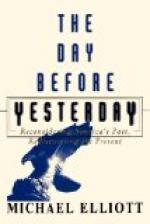Those swarthy, amply waistcoated, voluble little men were really very good fellows in spite of their excitability and torrents of talk.
The Southern Frenchmen divide Europe into the “Nord” and the “Midi.” The “Nord” is hardly worth talking about, the sun never really shines there, and no garlic or oil is used in cookery in those benighted regions. The town of Lyons is considered to be in the “Nord,” although we should consider it well in the south of France. To the curious in such matters, it may be pointed out that the line of demarcation between “Nord” and “Midi” is perfectly well defined. In travelling from Paris to Marseilles, between Valence and Montelimar, the observer will note that quite abruptly the type of house changes. In place of the high-pitched roof of Northern Europe the farm-houses suddenly assume flat roofs of fluted tiles, with projecting eaves, after the Italian fashion; at the same time the grey-green olive trees put in a first appearance. Then you are in the “Midi,” and any black-bearded, olive-complexioned, stumpy little men in the carriage will give a sigh of relief, for now, at last, the sun will begin to shine.
Nyons had been for two hundred years a Huguenot stronghold, so for a French town an unusual proportion of its inhabitants were Protestants, and there was, oddly enough, a colony of French Wesleyans there.
M. Ducros’ father had been the Protestant pasteur of Nyons for forty-four years. He was eighty-six years old, and on week-days the old gentleman dozed in the sun all day, and was quite senile and gaga. On Sundays, no sooner had he ascended the pulpit than his faculties seemed to return to him, and he would preach interminable but perfectly coherent sermons with a vigour astonishing in so old a man, only to relapse into childishness again on returning home, and to remain senile till the following Sunday.
The Ducros lived in a large farm-house on the outskirts of the town. It was a farm without any livestock, for there is no grass whatever in that part of France, and consequently no pasture for cattle or sheep. Every one in Nyons kept goats for milk, and, quaintly enough, they fed them on the dried mulberry leaves the silkworms had left over. For every one reared silkworms too, a most lucrative industry. The French speak of “making” silkworms (faire des vers-a-soie). Lucrative as it is, it would never succeed in England even if the white mulberry could be induced to grow, for successful silkworm rearing demands such continual watchfulness and meticulous attention as only French people can give; English people “couldn’t be bothered” to expend such minute care on anything they were doing.




